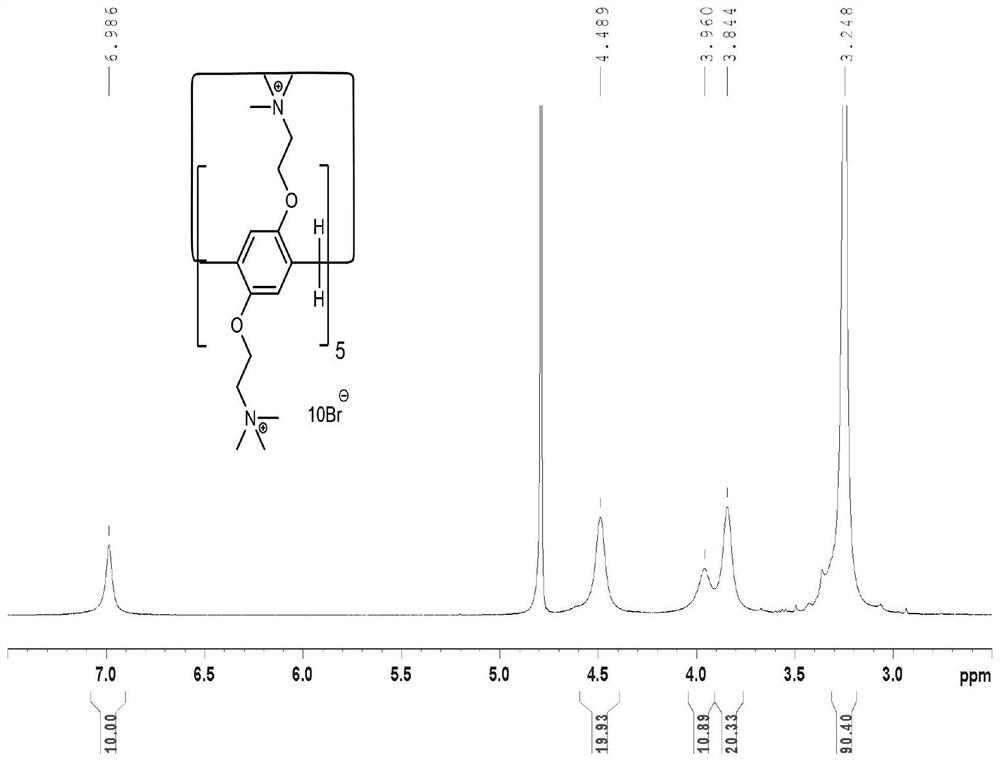Amphiphilic graphene quantum dot modified by water-soluble pillararene, preparation method and application thereof
A technology of graphene quantum dots and water-soluble pillar aromatic hydrocarbons, which is applied in the preparation of organic compounds, ether preparation, and ester reaction preparation of ethers, etc. Insufficient affinity and other problems, to avoid the introduction of impurities, improve affinity, and simple methods
- Summary
- Abstract
- Description
- Claims
- Application Information
AI Technical Summary
Problems solved by technology
Method used
Image
Examples
preparation example Construction
[0031] A method for preparing amphiphilic graphene quantum dots modified by water-soluble pillar aromatics, comprising the following steps: (1) preparing amphiphilic graphene quantum dots; (2) preparing water-soluble pillar aromatic hydrocarbons; Amphiphilic graphene quantum dots are mixed with water-soluble pillar arenes in aqueous solution, the alkyl chains on the amphiphilic graphene quantum dots are combined with the cavity of the pillar arenes through hydrophobic interaction, and the ammonium salts with cations on the pillar arenes are combined with The hydroxyl groups on the amphiphilic graphene quantum dots are combined by electrostatic interaction to obtain water-soluble pillar arene-modified amphiphilic graphene quantum dots.
[0032] The mixing in the step (3) is: the mass ratio of the amphiphilic graphene quantum dots to the water-soluble pillar arene is 1:1-4. Only within the above mass ratio range can the water-soluble pillararene be well combined with the amphiph...
Embodiment 1
[0037] The embodiment of the present invention provides a method for preparing water-soluble pillararene-modified amphiphilic graphene quantum dots, the specific steps are as follows:
[0038] Step 1: Mix 3.3.3g, 30mmol of hydroquinone and 11.056g, 80mmol of anhydrous potassium carbonate in a 250mL three-round-bottomed flask, and stir at 60°C for 2h under a nitrogen atmosphere. Then, 40 mL excess of 1,2-dibromoethane was added. The reaction mixture was stirred at 60 °C under nitrogen atmosphere for 24 h and filtered. The filtrate was evaporated on a rotary evaporator to remove 1,2-dibromoethane and solvent. The residue was dissolved in 100 mL of chloroform, washed three times with 50 mL of sodium hydroxide solution and twice with 50 mL of water. The extract was dried over anhydrous magnesium sulfate. Remove CHCl 3 , dried under vacuum at 40°C to obtain 1,4-bis(2-bromoethoxy)benzene with a purity of 35% as a light brown powder, and its synthesis diagram is shown in Figure ...
PUM
| Property | Measurement | Unit |
|---|---|---|
| Size | aaaaa | aaaaa |
| The average particle size | aaaaa | aaaaa |
Abstract
Description
Claims
Application Information
 Login to View More
Login to View More - R&D
- Intellectual Property
- Life Sciences
- Materials
- Tech Scout
- Unparalleled Data Quality
- Higher Quality Content
- 60% Fewer Hallucinations
Browse by: Latest US Patents, China's latest patents, Technical Efficacy Thesaurus, Application Domain, Technology Topic, Popular Technical Reports.
© 2025 PatSnap. All rights reserved.Legal|Privacy policy|Modern Slavery Act Transparency Statement|Sitemap|About US| Contact US: help@patsnap.com



